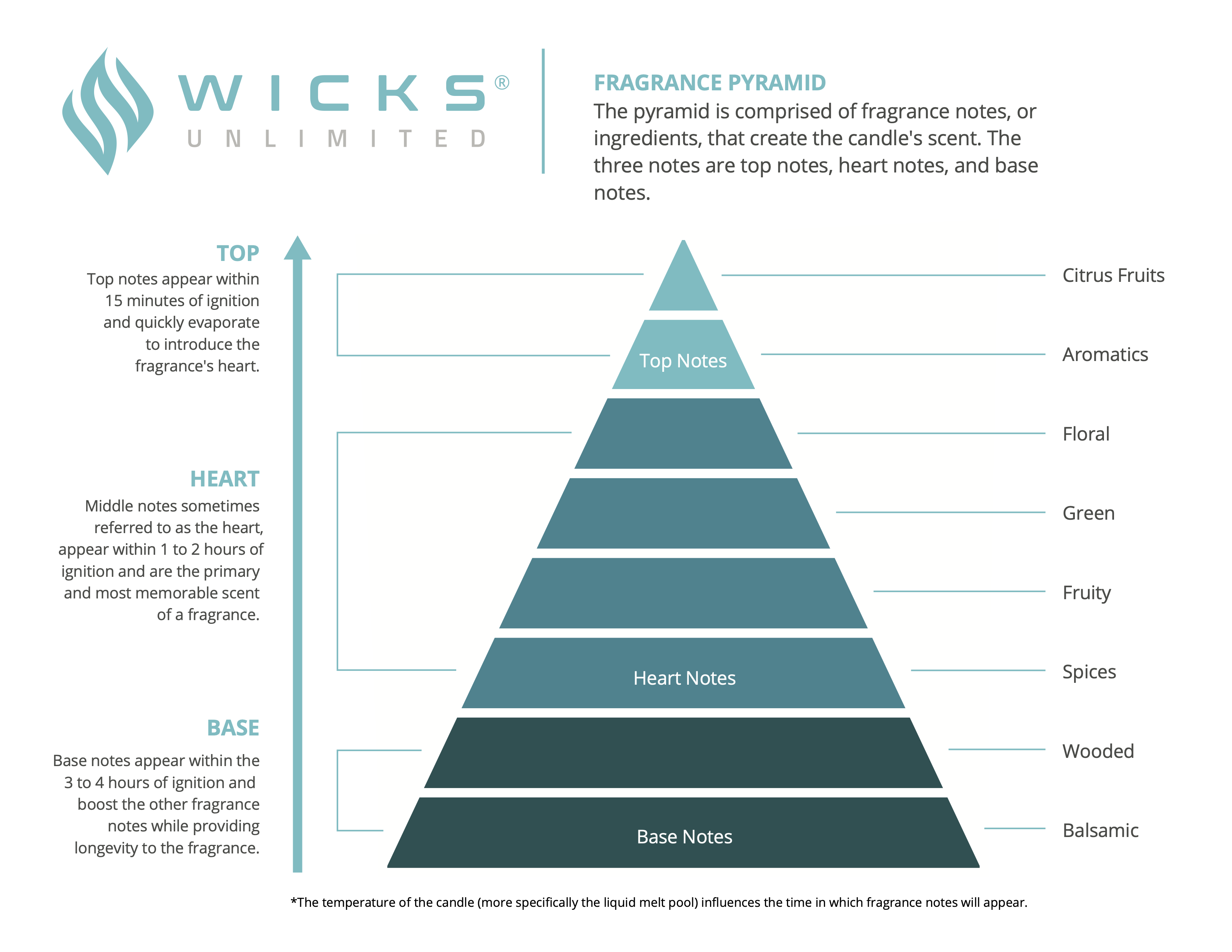Developing candles with a consistent cold and hot scent throw is an exact science. Each part of the candle system, including the wick, wax, sustainer and container, must work in harmony with the natural or synthetic fragrance oils, powders or essential oils for optimal combustion. Too much or too little fragrance will affect the combustion process and the end-user experience. In part one of this two part series focusing on the role fragrance plays in candle combustion, the experts at Wicks Unlimited introduce the reader to the differences between natural and synthetic fragrances and explore the different notes within the fragrance pyramid.
An Introduction to Natural and Synthetic Fragrances
Natural fragrances contain ingredients derived from natural origins. They typically have a mixture of essential oils extracted from blossoms, citruses, woods and leaves, spices and resins (botanical extracts), or from animals (musk). Synthetic fragrances sometimes called “fragrance oils,” are created in a laboratory. They are designed to mimic and enhance natural fragrances with a more potent and long-lasting scent throw. It is worth noting that synthetic fragrance manufacturers do not have to disclose the individual components of their fragrances since they are considered a trade secret.
To help illustrate and understand natural and synthetic fragrance notes, candle manufacturers rely on a fragrance pyramid. The fragrance notes are positioned within the pyramid based on their volatility. Scent notes at the very top of the pyramid evaporate faster and therefore are more volatile, while notes at the bottom evaporate slower and are longer lasting. Let’s quickly explore each section of the pyramid.

Top Notes
Top notes first appear within 15 minutes, are the first scents one smells, and play a significant role in the purchasing decision. These notes typically include light, fresh, and citrusy aromas and introduce the candle fragrance to the end-user via a cold throw. Scents that make up the top notes evaporate the fastest since they have the smallest molecules. Since scents in the top evaporate the quickest due to their molecular structure, it is vital to have the correct fragrance ratio to avoid premature evaporation.
Top Notes Characteristics
- Top notes appear with 15 minutes of ignition.
- Top notes include light, fresh, and citrusy aromas.
- Top notes play an important role in the purchasing decsion since they introduce the candle’s fragrance to the end-user via cold throw.
Middle Notes
Middle notes often called “heart notes,” appear within 1 to 2 hours of ignition and are more robust, complex, and full-bodied than top notes. They enhance the top and bottom notes by providing balance and harmony to the overall fragrance blend. Middle notes often are the most prominent and include florals, light fruits, and spicy fragrances.
Middle Notes Characteristics
- Middle notes appear within 1 to 2 hours of ignition.
- Middle notes provide balance and harmony to the overall fragrance blend and often include florals, light fruits, and spicy fragrance(s).
- Middle notes are more robust, complex, and full-bodied than top notes.
Base Notes
Base notes, sometimes called bottom notes, are the last to appear within 3 to 4 hours of ignition. They provide a foundation for the fragrance’s lighter notes since bottom notes are composed of larger molecules that are heavier and longer lasting. Popular base notes include vanilla, woodsy, and balsamic scents. Base notes also linger after the candle is extinguished, a feature many end-users enjoy.
Base Note Characteristics
- Base notes appear within 3 to 4 hours of ignition.
- Base notes provide a foundation for the fragrance’s lighter notes and often include vanilla, woodsy, and balsamic fragrance(s).
- Base notes are compromised of larger molecules and base note scents may linger after the candle is extinguished.
Finding a Balance Between Fragrance Levels and Combustion
Optimal candle combustion and scent throw is only achieved when each part of the candle system including the wick, wax, sustainer, and container work in harmony. Even if just one of those parts is off, the candle will not achieve an optimized burn or scent throw. In part two of this series on the role fragrance plays in candle combustion, the experts at Wicks Unlimited explore common combustion issues caused by candles with high-level fragrances and their solutions. Use the contact form below or call 954-946-3500 to speak with a team member today and partner with Wicks Unlimited to develop or troubleshoot candles with high levels of fragrance.



